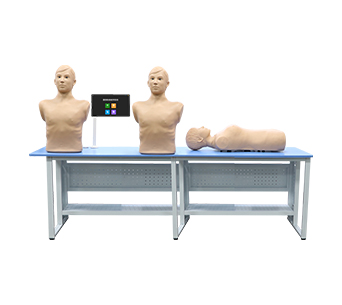System Overview
■ The
system mainly consists of two simulated chest examinations, one
simulated abdominal examination, a computer, and an experimental
platform. The computer is equipped with chest and abdominal examination
teaching software, which is wirelessly connected to the simulator via
USB or WIFI. There are two types of machines: teacher machines and
student machines.
■ The software system contains rich multimedia
content, including 3D simulation animations, 2D animations, live
teaching videos, detailed text explanations, and case images. According
to the textbook content, it integrates visual examination, palpation,
percussion, auscultation, and theoretical teaching of various common
disease signs in the respiratory system, circulatory system, and
abdomen, vividly explaining the anatomical changes of pathological signs
and the mechanism of auscultation sounds. The interface is vivid and
the operation is simple, reducing the intensity of teachers' theoretical
teaching in diagnosis and internal medicine, and improving teaching and
assessment effectiveness.
■ The software system has multiple
categories of assessment content and can be used for self practice, self
assessment, and joint control assessment. Equipped with an examination
system, it can manage multiple exam papers, including independent topic
selection and random system selection; The system has functions such as
exporting test papers, saving test papers, viewing grades, printing, and
automatic scoring by the system.
Chest examination simulated human
■
Simulate the real skeletal structure of a human lining, with clear body
surface markings and a realistic, soft, and smooth skin feel, meeting
the needs of body surface positioning.
■ Heart sounds can be
auscultated in the aortic valve area, pulmonary valve area, mitral valve
area (apex), tricuspid valve area, and the second auscultation area of
the aortic valve; Lung sounds can be achieved in the throat, anterior
axillary line, lower part, and middle axillary line and lower part;
Auscultation that covers multiple chest auscultation areas such as the
posterior axillary line, interscapular area, and subscapular area
simultaneously.
■ Using a clinical real stethoscope for auscultation
is more closely related to the clinical auscultation effect, and there
is no limit on the number of auscultators, achieving simultaneous
auscultation by multiple people, suitable for holistic teaching.
Abdominal examination simulated human
■
It can simulate different degrees of liver and spleen enlargement, and
the degree of enlargement can be freely set from 0CM to 8CM.
■ The
simulator can simulate abdominal breathing, with visible ups and downs
in the abdomen, which can be classified into three levels: depth,
normal, and shallow. Can simulate chest breathing movements, normal
breathing movements, and difficulty breathing.
■ The simulator can
simulate tenderness and rebound pain palpation points in at least 13
locations, including gallbladder point, stomach, pancreas point, left
quarter rib point/spleen, liver/right quarter rib point, small
intestine, appendix tenderness, bladder or uterus, ileocecal, left upper
ureteral point tenderness, right upper ureteral point tenderness, left
middle ureteral point tenderness, and right middle ureteral point
tenderness.
■ The system has the functions of question screening,
paper management, random question setting, teacher's independent topic
selection, automatic grading, saving of papers, and viewing of grades.









